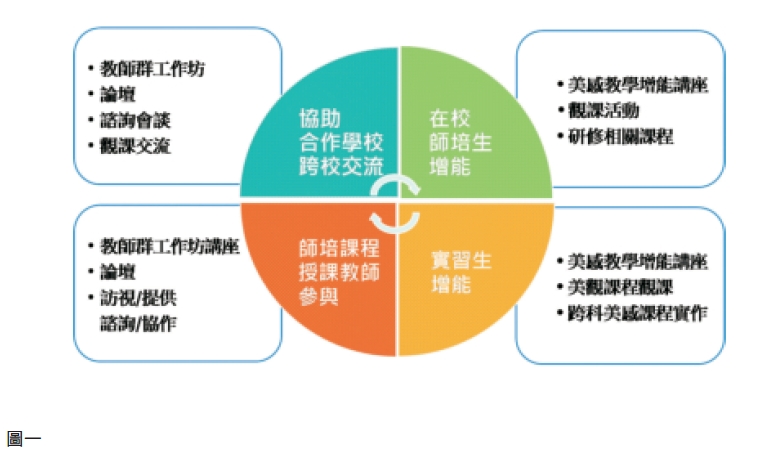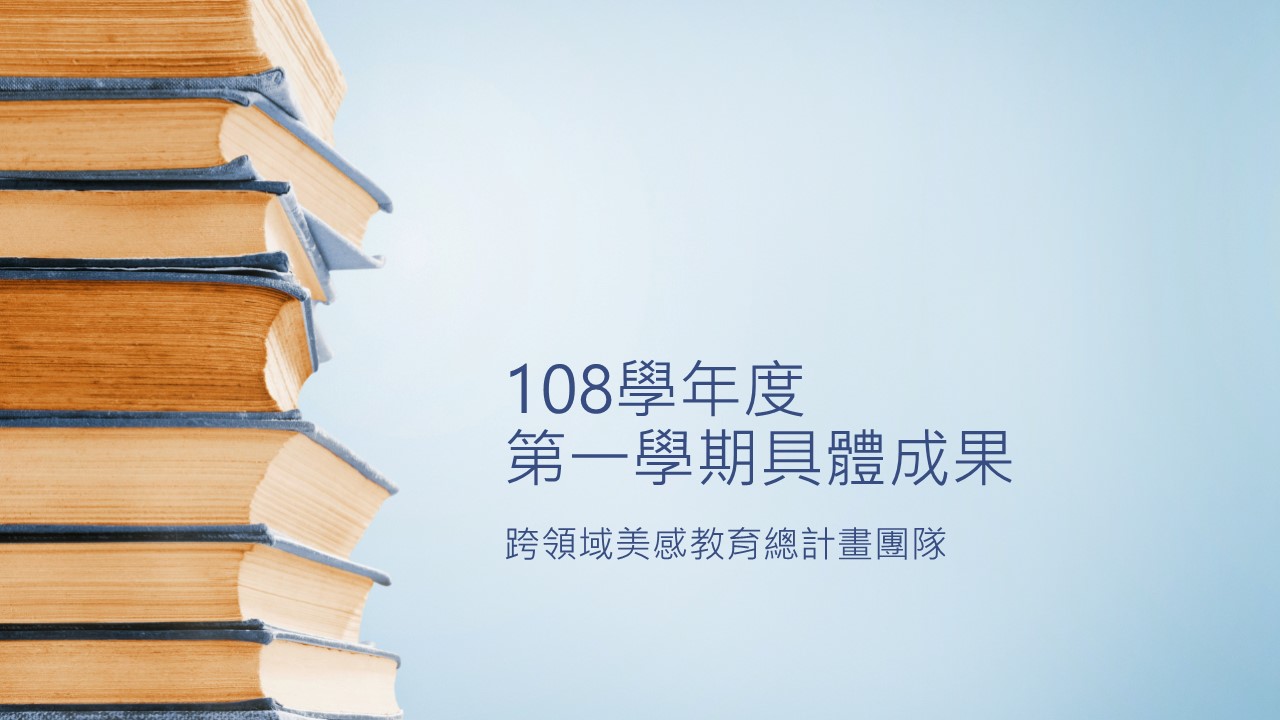Teacher Training University promotes the experience of cross-field aesthetic experimental courses
Professor Zheng Fangjing, Department of Music, National Tainan University
Roland. Bart said heartbrokenly: Is the artist dead?
We say: OK! As long as citizens generally possess aesthetic literacy, artists will not die!
1. Preface
Art education in Taiwan has long been subject to social values oriented toward higher education, and has always been regarded as a dispensable and marginal course in national education. Art subject teachers often complain about this. But we are also fortunate that such a neglected subject has not disappeared from the compulsory curriculum like in some other countries. However, compared to European and American countries (art courses are not necessarily compulsory in the state education), is the general aesthetic literacy or artistic literacy of Taiwanese citizens better? I believe that most people know the answer well, and most scholars and experts in the art education field also take this as their responsibility. Not only are they concerned about the central government's art education policies (such as curriculum formulation), but many people are also committed to developing new curriculum thinking, hoping to correct the inappropriate art education atmosphere and practices in the country, such as: "Cross-disciplinary education in secondary schools and elementary schools" "Aesthetic Education Experimental Curriculum Development Project" is a good example.
However, the frontline practitioners of the great cause of education are teachers of traditional Chinese education. If traditional Chinese education art teachers lack curriculum and teaching thinking that match the policy in terms of teaching concepts, it will be difficult to achieve twice the result with half the effort. Looking further, the cultivation of Chinese teachers relies on various teacher training institutions. Therefore, the promotion of cross-American experimental courses certainly cannot omit the participation of teacher training institutions. Domestic "senior" normal education universities, most of which are century-old, should be willing to participate in the promotion of cross-field aesthetic courses.
The author works at National Normal University and is fortunate to participate in this project. At the university end of teacher training, the author draws on curriculum theory (especially to review the design and planning of integrated courses), aesthetic psychology (to reflect on the improvement of aesthetic literacy) and teaching theory (to observe teachers’ teaching practices). to plan and participate in the promotion of this experimental course plan. We believe:
*Aesthetic education is the continuous accumulation of experiences that touch students’ five senses and soul (Lin Meijun, 2015).
*Aesthetic experience includes “making” and “affected” (Dewey, 1980)
* The accumulation of aesthetic experience will make beauty become a habit of people's life and a way of experiencing things. (Jalongo and Stamp, 1997)
2. Action framework for promotion of cross-field aesthetic courses for teacher training
Based on the above belief, the author considers the relevant aspects in teacher training institutions that have an impact on the promotion and improvement of art courses, including current teacher trainees, school interns, teacher training teachers, and cooperating primary and secondary schools. Therefore, at the beginning of the implementation, the entire promotion operation was planned into four major aspects, and the actual activity content of each aspect covered "empowerment", "practical exchange" or "implementation". The brief structure is summarized in the figure below, and the work outline is listed below.
(1) Enhancing the abilities of in-school teacher training students
1. Organize or develop opportunities for current teacher trainees to participate in empowerment lectures related to cross-disciplinary courses on aesthetics
2. Organize or develop opportunities for current teacher trainees to participate in class observation activities of cross-domain courses on aesthetics
3. Add relevant content of cross-education aesthetic courses to the established courses, and encourage current teacher trainees to study
(2) Increasing the capabilities of interns
1. Organize or develop opportunities for interns to return to school to participate in empowerment lectures related to cross-disciplinary courses on aesthetics
2. Organize or develop opportunities for interns to participate in class observation activities of cross-disciplinary courses on aesthetics
3. Guide interns to implement cross-domain aesthetic courses
(3) Assisting partner schools in cross-school exchanges and teacher empowerment
1. Organize teacher group workshops related to cross-domain aesthetic courses
2. Organize forums related to cross-domain aesthetic courses
3. Hold consultation meetings related to cross-domain aesthetic courses
4. Organize class observation and exchanges related to cross-domain aesthetic courses
(4) Participation and empowerment of teachers in teacher training courses
1. Organize teacher training group workshop lectures related to cross-domain aesthetic courses
2. Organize forums related to cross-domain aesthetic courses
3. Invite teacher training teachers to visit, provide consultation, or participate in collaborative talks
After setting up the above-mentioned implementation scaffolding and having specific work directions, we enter the strategic design stage of implementation, such as inviting consulting teachers from various fields, designing the schedule of work or activities, contacting relevant units... etc.
Essential principles for participation and promotion implementation
Entering the specific implementation stage, the author followed several principles to avoid deviating from the goal.
First of all, in order to accurately grasp the core goals and strategies of the original plan, we usually work closely with the National Normal University Planning Headquarters to correctly complete the assigned tasks. As far as the author understands, the assigned task is firstly to monitor the implementation status of cross-domain aesthetic experimental courses in various primary and secondary schools that cooperate with this project, and secondly to provide teacher trainees of the school where the author teaches to observe the experimental courses of these seed schools. Chance. However, when I first accepted the task in February 2017 (Part 106), my personal understanding of the task content was quite vague, and the implementation strategy was conservative. Fortunately, with the gentle assistance of the assistants at the planning headquarters, I was able to slowly clarify it. Since 107 Since the beginning of last semester, I have been able to boldly create new implementation methods and content.
Then we actively contacted teacher training professors, cooperative schools, affiliated primary schools and other related teachers to provide them with exchange opportunities. Although there are various models for curriculum development in theory, such as the Tyler model and the Taba model...but there is always a gap between theory and practice. Due to the disguise of time and space, it is not something that can be completely standardized. Even experts and scholars cannot solve the problems of front-line teachers. They even have to learn from front-line teachers how to implement the curriculum in reality. The author believes that mutual learning through forums, workshops and collaborative talks is a necessary part of promotion work. Therefore, we are committed to providing networking opportunities. However, the author is well aware that most teachers in schools at all levels are busy with their daily teaching work, and cross-educational aesthetic courses are an additional burden. Therefore, exchange activities must consider the time load of school teachers, and decided to use one or two sessions per semester as a principle, and hope that The content complements the form, and teachers must gain something from it.
Collect the implementation experience and suggestions on the cross-field aesthetic courses and provide reference to the planning headquarters to facilitate the Ministry of Education in formulating relevant policies in the future. 107 At the beginning of last semester, I received the task of "visiting" due to the participation of national primary schools. According to the author's personal understanding, this task, in addition to assisting the implementation of experimental courses, is to listen to the front-line executors (including teachers). , administrative facilitator) for questions, opinions and suggestions about the experimental course. Therefore, the author made an appointment to visit each of the 18 primary and secondary schools assigned to me by the planning headquarters, but there were still two schools that were omitted because the two parties could not agree on the time.
The author implements cross-field aesthetic courses and wears the aura of an expert, scholar or advisory committee member, and often feels ashamed of himself. Because except for the music teaching method training I received during my stay in the United States, which was based on a slightly unified concept, I have no real experience in implementing cross-field courses in the university courses I teach, and can only introduce theories. With such a blank experience, how do you know what the possible problems are for front-line executors? How can we help? For this reason, the author used courses that he could control in the two semesters of the 107 academic year and tried to implement them in certain units in a cross-field manner. It is hoped that this kind of mental journey can deepen the observation of cooperative schools or seed schools.
4. Results and reflections
(1) Feedback and suggestions from cooperative schools
The author summarizes the opinions expressed by the teachers of the cooperative schools in all the forums, lectures, and visits held in the past year and a half.
The opinions are summarized and briefly listed below.
1. The enthusiasm of primary and secondary school teachers is admirable
2. Both home-cooked and feast-style courses are helpful. Most of the content is based on art courses combined with humanistic care, especially visual art, using art as a tool to activate other subjects. However, it is worth exploring whether students' aesthetic literacy has been improved, that is, the effectiveness of learning the essence of art.
3. Most partner schools (more than 90%) are grateful to have the opportunity to participate in such an experimental course.
4. Most of the partner schools (more than 90%) said that the school’s administrative cooperation is good.
5. Some schools mentioned (about 50%) that how to implement it on a regular basis is an important challenge to consider in the future, and may also require more financial support.
6. Almost all teachers in cooperative schools said that joint curriculum preparation and cross-field mutual assistance are in good condition, but the author found that few expressed opinions on curriculum evaluation and reflection.
7. Based on the above point, the author’s observation shows that the focus, strategy and implementation level of learning assessment in cross-domain aesthetic experimental courses need to be discussed.
8. Most schools are exploring while doing it, and the curriculum development model has not yet been established. Teachers in most partner schools (more than 60%) are looking forward to more relevant learning and enhancement opportunities.
(2) Reflections on teacher training institutions and teachers
The university where the author works is an old teacher training school. The administrative structure related to teacher training and curriculum implementation is quite sound. Therefore, when I first accepted the task, I consulted with the supervisor of the teacher training center and received valuable opinions. Therefore, through The school's administrative mechanism can notify all teacher training teachers and teacher training students of relevant activities held. In the process of inviting advisory committee teachers, looking for cross-domain course partners, and conducting related empowerment activities, the author found several points worthy of consideration.
There are many teachers at Normal University who care about cross-field courses and are conducting many related researches. However, this type of teachers almost conduct personal theoretical research, guide students on special projects, and guide primary and secondary schools outside the school. There are few who prepare courses with their peers and implement them in relevant courses in the school.
The consensus among teacher training teachers needs more dialogue, especially the issue of how to maintain sufficient basic skills training for undergraduates in a limited time while expanding their perspectives across fields? As mentioned in the previous point, professors are busy with personal research or project research. There are very few people who are willing to carry out cross-field co-preparation and collaborative teaching of on-campus courses. Some professors believe that the current education system has caused students to seriously lose their basic skills. Teaching within a limited time leaves no room for cross-field teaching. Some even think that it is unnecessary. Listening to him talk about his ideas, there is something worth pondering.
The activities related to this project at the Normal University are not compulsory and are all subject to free registration, so they cannot achieve comprehensive results. In the past year and a half, the teacher training teachers’ response to the relevant empowerment activities organized in the school where they teach cannot be said to be enthusiastic, interested, or caring. However, I believe that regardless of whether we are on the positive or negative side, there is value in dialogue and we can learn from each other.
(3) Responses from teacher trainees/interns
Promotional actions at the university level of teacher training not only target teacher training teachers to gain understanding and cooperation, but also provide opportunities for experience and understanding for future teachers - teacher training students. First of all, in the second semester of 105, the author personally cooperated with education-related courses, giving short lectures on class promotion, as well as return-to-school or pre-employment lectures for interns. In addition, I also held class observations in affiliated primary schools. Unfortunately, due to transportation problems, I was unable to observe in other cooperative schools. More creative cross-domain courses. Of course, the various lectures and workshops held on campus are also open to teacher trainees and interns. Furthermore, on 106, the interns guided by the author are also encouraged to take cross-field aesthetic courses with the permission of the internship school. The feedback and opinions of these students are summarized and briefly listed below.
1. Most of the teacher trainees/interns participating in the activity are interested in cross-field courses from a learning perspective. They not only affirm their value but are also willing to learn more.
2. Teacher training students are confused about the lack of cross-field courses in teacher training courses.
3. Relevant activities at the Teacher Training University in conjunction with this plan are not compulsory and are all subject to free registration. The level of participation of teacher training students is not high and comprehensive results cannot be achieved. I really need further encouragement from my teacher.
Curriculum is indeed a plan, a teaching goal, and an experience. It can also be said to be all the learning opportunities provided to students. But no matter what, it won't happen overnight. This wave of experimental courses is valuable experience for future art education decisions, but what lingers in my mind is whether the students have really improved their aesthetic literacy? I believe that once the entire country becomes aesthetically literate, Taiwan's art ecology will definitely change.
It is an honor for me to be a member of the promotion of cross-field aesthetic experimental courses.
This article is included in "What Class Is This - Imagination and Practice of Cross-Field Aesthetics Courses", Taipei: National Taiwan Normal University, 2018




